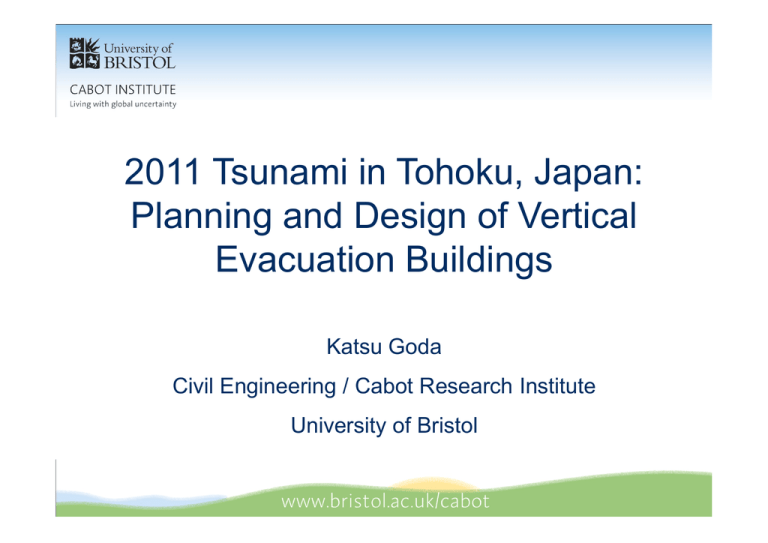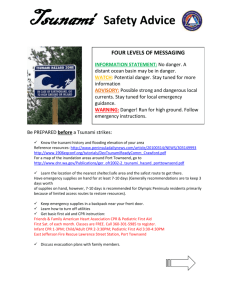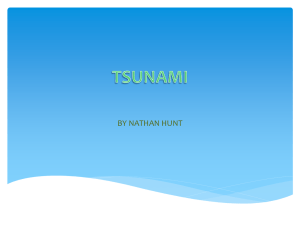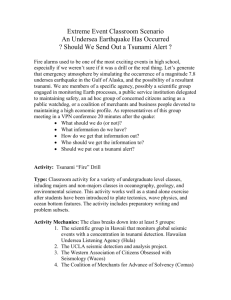2011 Tsunami in Tohoku, Japan: Pl i d D i
advertisement

2011 Tsunami in Tohoku, Japan: Pl Planning i and d Design D i off V Vertical ti l Evacuation Buildings Katsu Goda Civil Engineering / Cabot Research Institute University of Bristol Content • Mw9.0 11th March 2011 Tohoku earthquake and tsunami damage • Performance of tsunami protection • Vertical evacuation buildings – a case study for Yamamoto • Key lessons EEFIT-Tohoku Mission • 9 members • May 27 to June 3, 2011 • Wide spatial area • Focus on tsunami affected locations along the coast • Ground shaking g damage, landslide, liquefaction, etc. Earthquake Facts Kesennuma • Very large earthquake: Mw9.0 • Catastrophic tsunami damage • 19000+ death/missing • Direct loss: 300-400 billion U.S. dollars • Fukushima F k hi Daiichi D ii hi nuclear l power plant crisis • Infrastructure damage – levee, road, bridge, railway, water treatment plant plant, industrial facilities, General Damage Statistics • Widespread damage to buildings – concentrated in Iwate/Miyagi/Fukushima. This includes both tsunami-affected and shaking-affected cases. Damage statistics from National Police Agency Prefecture Iwate Miyagi Fukushima Ibaraki Tochigi Gunma Saitama Chiba Tokyo Kanagawa Others Total Total collapse 20998 65462 15885 2179 257 0 0 771 0 0 343 105895 Half collapse 3174 48684 29125 14873 2074 6 5 8056 11 7 959 106974 Partial damage 2668 76785 92455 132921 56799 16145 1800 27714 257 279 110 407933 Nonresidential damage 1538 17826 1015 8551 295 195 33 708 20 1 1673 31855 Road 30 390 19 307 257 7 160 2343 13 0 33 3559 Earthquake and Tsunami • Mw9.0 9 0 mega-thrust mega thrust earthquake occurred at 2:46:23 pm pm. • It triggered tsunamis more than 10 m high, causing immense tsunami damage • Significant deformation on land – up to 1 m subsidence Colour contour: slip V t ground Vector: d deformation d f ti (Simons et al. 2011) Was This Tsunami Forecasted? • The Sanriku coast suffered tsunamis in 1896, 1933, and 1960 earthquakes repeatedly. • The 2011 event generated much larger tsunami waves. Nobody had expected such high tsunami. • However, historical records indicate such massive tsunamis did occur in the past – e.g. 1611 Keicho tsunami and 869 Jogan tsunami. Rikuzen Takata Only several buildings are standing … Sendai Kamaishi • Deepest p seawall in the world • 9.0+ m inundation • One vertical evacuation building performed well – with sacrifice structure & breakable partition wall Taro • 10-m high walls over 2 km – a well-protected town against tsunami – did not protect the town completely p y – but significantly reduced the damage. Tsunami Casualty Mitigation • Lots L t off di discussion i on what h t iis th the b bestt strategy t t tto reduce d the th number of fatalities in the future catastrophic tsunami. • Option O i 1 1: A As iit iis; sufficient ffi i tsunamii protection i – Fudai. F d i • Option 2: Rebuild the protection structures with higher capacity – Taro. • Option 3: Relocation of an entire town/city to high ground – Noda. • Option 4: Combination of horizontal and vertical evacuation structures Design of Vertical Evacuation Buildings • 19000+ death disproportionate risks for elderly (75% of d h for deaths f age 50+). ) • Both horizontal and vertical evacuation must be improved. • Different strategies for different communities (topography sea (topography, defence, tsunami hazard, demography , etc.) FEMA (2008) Design of Vertical Evacuation Buildings • Input p information – tsunami height and velocity at a location • Various forces act on buildings subjected to tsunami: hydrostatic force, hydrodynamic force, debris, buoyant force, etc. FEMA (2008) Case Study for Yamamoto (1) • Coastal p plains;; Aging g g society; y; 676 deaths;; onlyy one vertical evacuation building Case Study for Yamamoto (2) • Post-tsunami survey was conducted d t d iin N Natori t ib by Murakami et al. (2012) Awareness for tsunami risk • Tsunami T i warning i was heard h d through: radio, TV, municipalities/police • Use of cars Timing of evacuation 4 18 Travel means for evacuation Before shaking ended 31 On foot/running O oot/ u g Right after shaking 33 Bicycle Some time after shaking 14 In damgerous situations 31 Did not evacuate 66 2 1 Motor bike Car Case Study for Yamamoto (3) • Five sites for vertical evacuation buildings; Anticipated inundation height plus some freeboard; Coverage area - 500 m radius; Occupancy: local needs for services • Assume 600 lives saved; 80K GBP/life versus 20-30K GBP/quality yyear;; Cost-effective! Inundation depth (m) Design tsunami height (m) Building height (m) [# of storeys] Covered population [Floor area (m2)] Cost (million GBP) Site 1: Care home 1.95 5.54 14 & [4] 1320 & [2400] 18.1 Site 2: Elem. school 1.85 5.41 14 & [4] 1030 & [1500] 10.82 Sit 3 Site 3: Sports S t centre t 4 09 4.09 8 32 8.32 14 & [3] 780 & [1000] 6 15 6.15 Site 4: Post office 10.49 16.64 17.5 & [5] 740 & [800] 6.89 Site 5: Fish process. plant 7.76 13.09 17.5 & [5] 970 & [1000] 5.53 Evacuation building site & occupancy type Case Study for Yamamoto (4) • 500 m radius p primaryy catchment and extended catchment • Open ground space, breakaway walls • Structural design: lateral forces and pile foundation Key Lessons • Imagine extreme situations – scenarios! • Combination of soft and hard measures – resistant structures plus emergency planning/evacuation. • Multi-layer M lti l protection t ti – system t robustness & resilience. • Cooperation C ti among victims, i ti S lf SelfDefence Forces, municipalities, NGOs/NPOs companies, NGOs/NPOs, companies governments, governments foreign aids, etc. Acknowledgements • EPSRC funded three team members (including KG) KG). • EEFIT-Tohoku members and supporting staff •S S. Li Li, II. Dasiewics Dasiewics, M M. Quinn Quinn, and JJ. Zhang for their passion to conduct a UG design project (Univ. of Bristol) EEFIT corporate sponsors:





